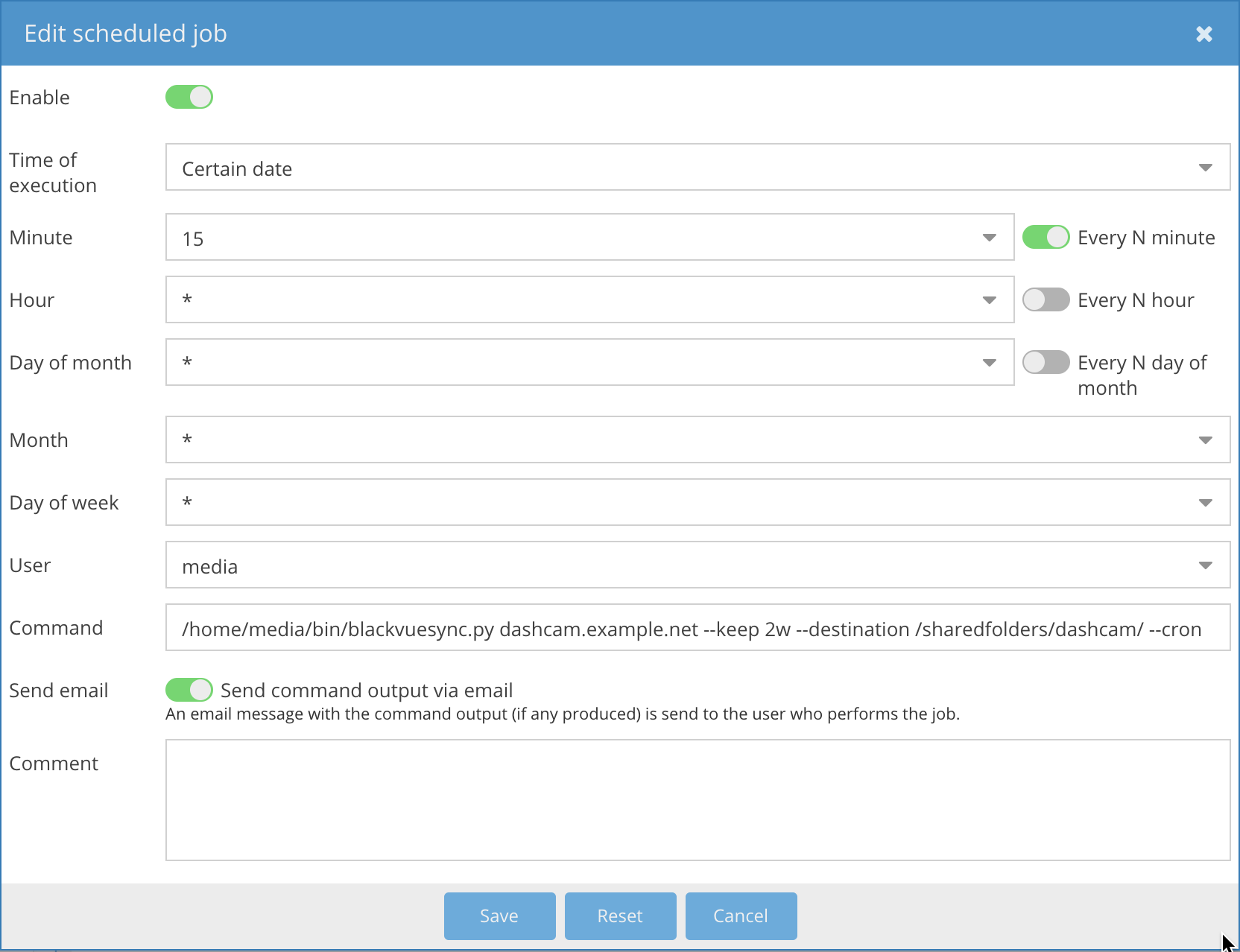Synchronizes recordings from a BlackVue dashcam with a local directory over a LAN.
BlackVue dashcams expose an HTTP server -- sadly no HTTPS, that can be used to download all recordings. This project downloads only recordings that are not already downloaded, optionally limiting downloads in a local directory to a date range.
A typical setup would be a periodic cron job or a docker container running on a local server.
- Portable runtimes:
- A single, self-contained Python script with no third-party dependencies that can be can just be copied and run anywhere either manually or periodically, or:
- A docker image that runs said script periodically via an internal cron job.
- Smart: Only downloads recordings that haven't been downloaded yet.
- Resilient: If a download interrupts for whatever reason, at the next run the script resumes where it left off. This is especially useful for possibly unreliable Wi-Fi connections from a garage.
- Hands-off: Optionally retains recordings for a limited amount of time, removing outdated ones.
- Cron-friendly: Only one process is allowed to run at any given time for a specific download destination.
- Safe: Stops executing if the disk is almost full.
- Friendly error reporting: Identifies a range of known error conditions and clearly communicates them.
- Python 3.5+ or Docker.
- A BlackVue dashcam connected to the local network with a fixed IP address.
- Recordings must be downloaded to a destination on a local filesystem.
Tested with: DR750S
Untested, but should work with: DR900S, DR650S, DR590/590W, DR490/490L Series.
Reports of models working or not other than those tested are appreciated.
For all examples, we will assume that the camera address is dashcam.example.net. A numerical IP address works just as well.
A quick way to verify that the dashcam is reachable via the local network is by using curl.
$ curl http://dashcam.example.net/blackvue_vod.cgi
v:1.00
n:/Record/20181026_135003_PF.mp4,s:1000000
n:/Record/20181026_140658_PF.mp4,s:1000000
n:/Record/20181026_140953_PF.mp4,s:1000000
...
$
Another way is to browse to: http://dashcam.example.net/blackvue_vod.cgi.
The dashcam address is the only required parameter. Specifying --dry-run makes it so that the script communicates what it would do without actually doing anything. Example:
$ blackvuesync.py dashcam.example.net --dry-run
It's also possible to specify a destination directory other than the current using --destination:
$ blackvuesync.py dashcam.example.net --destination /mnt/dashcam --dry-run
A retention period can be indicated with -keep -- e.g., two weeks. Recordings prior to the retention period will be removed from the destination. Accepted units are d for days and w for weeks. If no unit is indicated, days are assumed.
$ blackvuesync.py dashcam.example.net --destination /mnt/dashcam --keep 2w --dry-run
A typical invocation would then be:
$ blackvuesync.py dashcam.example.net --destination /mnt/dashcam --keep 2w
Other options:
--max-used-disk: Downloads stop once the specified used disk percentage threshold is reached. Defaults to 90%.--timeout: Sets a timeout for establishing a connection to the dashcam, in seconds. This is a float. Defaults to 10.0 seconds.--quiet: Quiets down output messages, except for unexpected errors. Takes precedence over-verbose.--verbose: Increases verbosity. Can be specified multiple times to indicate additional verbosity.
The script can be automatically run periodically by setting up a cron job on UNIX systems.
Simple example with crontab for a hypothetical media user:
*/15 * * * * /home/media/bin/blackvuesync.py dashcam.example.net --keep 2w --destination /mnt/dashcam --cron
The --cron option changes the logging level with the assumption that the output will be emailed. When this option is enabled, the script will only log when normal recordings are downloaded and when unexpected error conditions occur. One would typically see an email only after driving or when something goes wrong.
Note that if the dashcam is unreachable for whatever reason, in --cron mode no output is generated, since this is an expected condition whenever the dashcam is away from the local network.
The openmediavault NAS solution allows for scheduled jobs with support for mail notifications.
Example:
The acolomba/blackvuesync docker image sets up a cron job internal to the container that runs the synchronization operation every 15 minutes.
It's a good idea to do a single, interactive dry run first with verbose logging:
docker run -it --rm \
-e ADDRESS=dashcam.example.net \
-e DRY_RUN=1 \
-e VERBOSE=1 \
-e RUN_ONCE=1 \
--name blackvuesync \
acolomba/blackvuesync
Once that works, a typical invocation would be similar to:
docker run -d --restart unless-stopped \
-e ADDRESS=dashcam.example.net \
-v /mnt/dashcam:/recordings \
-e PUID=$(id -u) \
-e PGID=$(id -g) \
-e TZ="America/New_York" \
-e KEEP=2w \
--name blackvuesync \
acolomba/blackvuesync
To operate correctly, the docker image requires at a minimum:
- The
ADDRESSparameter set to the dashcam address. - The
/recordingsvolume mapped to the desired destination of the downloaded recordings. - The
PUIDandPGIDparameters set to the desired destination directory's user id and group id. - The
TZparameter set to the same timezone as the dashcam. Note that BlackVue dashcams do not respect Daylight Savings Time, so their clock needs to be adjusted periodically.
Other parameters:
KEEP: Sets the retention period of downloaded recordings. Recordings prior to the retention period will be removed from the destination. Accepted units aredfor days andwfor weeks. If no unit is indicated, days are assumed. (Default: empty, meaning recordings are kept forever.)MAX_USED_DISK: If set to a percentage value, stops downloading if the amount of used disk space exceeds the indicated percentage value. (Default: 90, i.e. 90%.)TIMEOUT: If set to a float value, sets a connection timeout in seconds. (Default: 10.0 seconds.)VERBOSE: If set to a number greater than zero, increases logging verbosity. (Default: 0.)QUIET: If set to a value, quiets down logs; only unexpected errors will be logged. (Default: empty.)CRON: Set by default, makes it so downloads of normal recordings and unexpected error conditions are logged. Can be set to""to disable.DRY_RUN: If set to a value, makes it so that the script communicates what it would do without actually doing anything. (Default: empty.)RUN_ONCE: If set to a value, the docker image runs the sync operation once and exits without setting up the cron job. (Default: empty.)
This project is licensed under the MIT License - see the COPYING file for details
Copyright 2018 Alessandro Colomba
